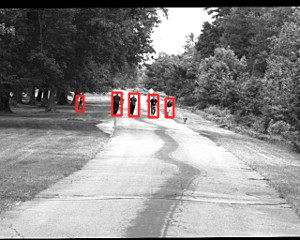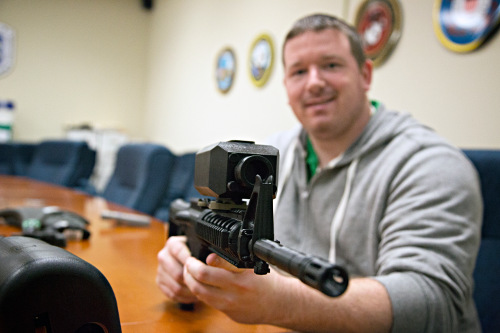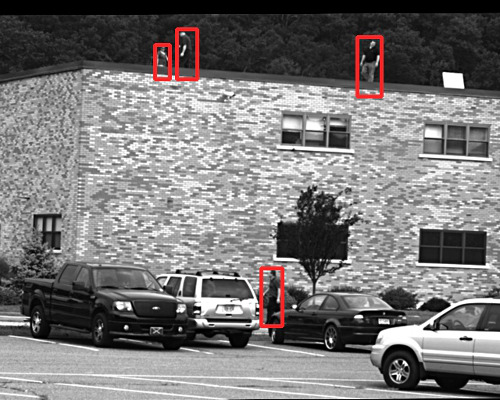 |
| March 24, 2015 | Volume 11 Issue 12 |
Designfax weekly eMagazine
Archives
Partners
Manufacturing Center
Product Spotlight
Modern Applications News
Metalworking Ideas For
Today's Job Shops
Tooling and Production
Strategies for large
metalworking plants
U.S. Army researchers advance fire control technology

Human-like figures are recognized and tracked with Small Arms Weapons and Fire Control software. [Photo Credit: Screenshot by Nick Serino]
Imagine you are a young Soldier on a deployment, and you do not have an awful lot of experience in firing your weapon at great distances. You are on patrol in a mountainous terrain with your fire team when suddenly you spot what appears to be the enemy. You see them, but they do not see you.
How do you take the shot? But more importantly, how do you take the shot and not miss so you do not get spotted and jeopardize your team's position?
Advances in fire control technology are progressing toward making it possible for the shooter to not only determine the exact range on target, but also track and hit the target up to the weapon's maximum effective range.
What is fire control?
Fire Control is the science of offsetting the direction of weapon fire from the line of sight to the target in order to hit the target.
The focus of Small Arms Weapons and Fire Control (SAW & FC) is technical fire control, which is the ability to detect, identify, and acquire targets, including range, and provide an updated ballistic solution determination.
Small arms fire control provides computational and mechanical operations required for a weapon system to hit a specific target with a specific munition.
"Our final goal is to increase lethality through better precision in range determination and target detection/tracking," says Wai Luk, Systems Engineering Lead.
Nicholas Serino, Project Officer for Small Arms Weapons and Fire Control at the U.S. Army Armament Research, Development and Engineering Center (ARDEC), says that there are two main components to the project that will eventually land in the hands of the U.S. Army Project Manager Soldier Weapons in Fiscal Year 2015.
The first part is a laser range finder that gets an exact range on target.
"It would save the Soldier, at minimum, a couple seconds," Serino says. "Those seconds could save lives."
The second part of the program is a target tracking software that can detect items that the normal eye would not normally be able to see at great distances. The most important being potential threats such as enemy combatants.

Nick Serino, ARDEC Project Officer for Small Arms Weapons and Fire Control, holds a 3D-printed M4 rifle representative of the Small Arms Weapons and Fire Control (SAW & FC) technology used on an individual weapon. Currently, the technology is planned to go to the M2 and the M240, however the software would work for any weapon. [Photo Credit: Erin Usawicz]
History
The program started in March 2012. Currently, there are six engineers who work on the Small Arms Weapons and Fire Control Project; a request that came after a Small Arms Capability Assessment was conducted in April 2008.
"Both the software and hardware would replace existing optics," Serino says.
Successes
A hardware test on the laser range finder was conducted at White Sands Missile Range in White Sands, NM, January 2013.
Engineers successfully calculated distances of objects up to 1,200 m away within just 1 to 2 m of the exact distance.
"At that range, it's like aiming for the chest and shooting at the belly button. You are still right on target," Serino says.
Luk says that without this technology, Soldiers can only accurately hit their target about 40 percent of the time when engaging the enemy at 600 m.
"This doubles that and some," Luk says.
Software
The software program was designed by Intelligent Automations in Rockville, MD.
The program is based on motion and looks for human characteristics.

Targets are tracked and outlined here in this screenshot taken from Small Arms Weapons and Fire Control software at Picatinny Arsenal, NJ. [Photo Credit: Screenshot by Nick Serino]
"One problem we had at first was that it created false positives for things like swaying trees," Serino says.
The software has since been updated and corrected.
"We are on the second phase of the project," Luk says, "software enhancement."
When the system recognizes a human-like figure, it places a box around the figure so that the user can constantly track his or her motion. Right now the box is red, but the program will allow for multiple colors to distinguish between one or more objects that may appear.
The hardware contains processor boards with embedded tracking algorithms and a beam steerer to steer a laser beam to the target in real and or near-real time.
Target locations can be relayed and handed off to other assets such as close combat attack or placed into a call for fire.
Target tagging and handoff allows targets in defilade or obstructed by obstacles to be engaged by cueing the engagement to another shooter.
Use of location tagging and shared target locations gives small unit leaders new options for improved command and control of their units, and better methods for fire control and distribution of organic weapon systems.
The program will eventually allow for vehicle identification and tracking as well.
Quick facts
Works on the M240 7.62-mm machine gun and the M2 .50-caliber machine gun.
Costs $18,000 to $25,000 per unit.
Published March 2015
Rate this article
View our terms of use and privacy policy
